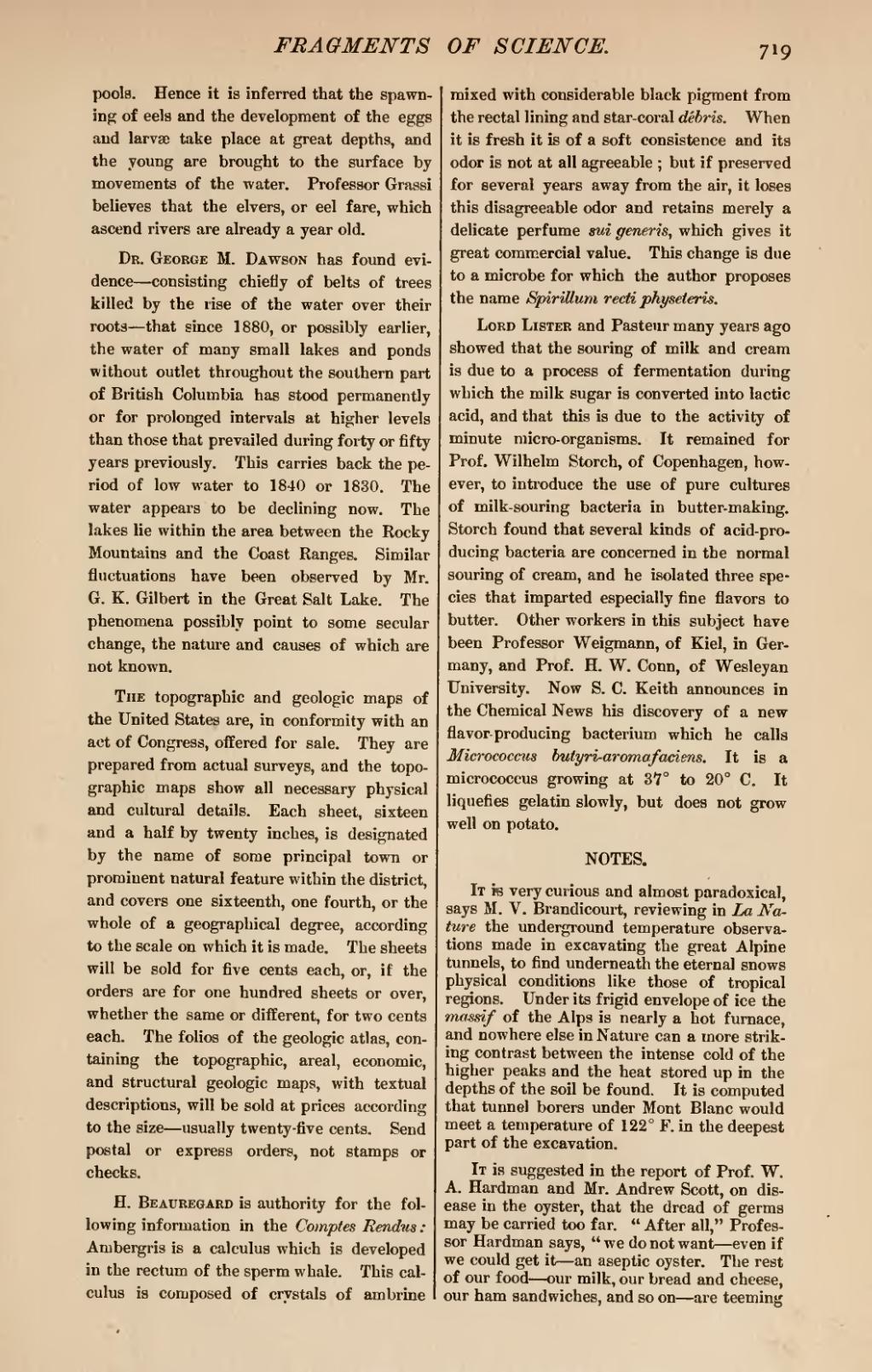pools. Hence it is inferred that the spawning of eels and the development of the eggs and larvæ take place at great depths, and the young are brought to the surface by movements of the water. Professor Grassi believes that the elvers, or eel fare, which ascend rivers are already a year old.
Dr. George M. Dawson has found evidence—consisting chiefly of belts of trees killed by the rise of the water over their roots—that since 1880, or possibly earlier, the water of many small lakes and ponds without outlet throughout the southern part of British Columbia has stood permanently or for prolonged intervals at higher levels than those that prevailed during forty or fifty years previously. This carries back the period of low water to 1840 or 1830. The water appears to be declining now. The lakes lie within the area between the Rocky Mountains and the Coast Ranges. Similar fluctuations have been observed by Mr. G. K. Gilbert in the Great Salt Lake. The phenomena possibly point to some secular change, the nature and causes of which are not known.
The topographic and geologic maps of the United States are, in conformity with an act of Congress, offered for sale. They are prepared from actual surveys, and the topographic maps show all necessary physical and cultural details. Each sheet, sixteen and a half by twenty inches, is designated by the name of some principal town or prominent natural feature within the district, and covers one sixteenth, one fourth, or the whole of a geographical degree, according to the scale on which it is made. The sheets will be sold for five cents each, or, if the orders are for one hundred sheets or over, whether the same or different, for two cents each. The folios of the geologic atlas, containing the topographic, areal, economic, and structural geologic maps, with textual descriptions, will be sold at prices according to the size—usually twenty-five cents. Send postal or express orders, not stamps or checks.
H. Beauregard is authority for the following information in the Comptes Rendus: Ambergris is a calculus which is developed in the rectum of the sperm whale. This calculus is composed of crystals of ambrine mixed with considerable black pigment from the rectal lining and star-coral débris. When it is fresh it is of a soft consistence and its odor is not at all agreeable; but if preserved for several years away from the air, it loses this disagreeable odor and retains merely a delicate perfume sui generis, which gives it great commercial value. This change is due to a microbe for which the author proposes the name Spirillum recti physeteris.
Lord Lister and Pasteur many years ago showed that the souring of milk and cream is due to a process of fermentation during which the milk sugar is converted into lactic acid, and that this is due to the activity of minute micro-organisms. It remained for Prof. Wilhelm Storch, of Copenhagen, however, to introduce the use of pure cultures of milk-souring bacteria in butter-making. Storch found that several kinds of acid-producing bacteria are concerned in the normal souring of cream, and he isolated three species that imparted especially fine flavors to butter. Other workers in this subject have been Professor Weigmann, of Kiel, in Germany, and Prof. H. W. Conn, of Wesleyan University. Now S. C. Keith announces in the Chemical News his discovery of a new flavor-producing bacterium which he calls Micrococcus bulyri-aromafaciens. It is a micrococcus growing at 37° to 20° C. It liquefies gelatin slowly, but does not grow well on potato.
It re very curious and almost paradoxical, says M. V. Brandicourt, reviewing in La Nature the underground temperature observations made in excavating the great Alpine tunnels, to find underneath the eternal snows physical conditions like those of tropical regions. Under its frigid envelope of ice the massif of the Alps is nearly a hot furnace, and nowhere else in Nature can a more striking contrast between the intense cold of the higher peaks and the heat stored up in the depths of the soil be found. It is computed that tunnel borers under Mont Blanc would meet a temperature of 122° F. in the deepest part of the excavation.
It is suggested in the report of Prof. W. A. Hardman and Mr. Andrew Scott, on disease in the oyster, that the dread of germs may be carried too far. "After all," Professor Hardman says, "we do not want—even if we could get it—an aseptic oyster. The rest of our food—our milk, our bread and cheese, our ham sandwiches, and so on—are teeming
